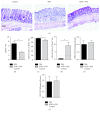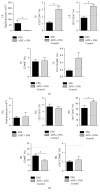Adrenal-Derived Hormones Differentially Modulate Intestinal Immunity in Experimental Colitis
- PMID: 27403034
- PMCID: PMC4923585
- DOI: 10.1155/2016/4936370
Adrenal-Derived Hormones Differentially Modulate Intestinal Immunity in Experimental Colitis
Abstract
The adrenal glands are able to modulate immune responses through neuroimmunoendocrine interactions and cortisol secretion that could suppress exacerbated inflammation such as in inflammatory bowel disease (IBD). Therefore, here we evaluated the role of these glands in experimental colitis induced by 3% dextran sulfate sodium (DSS) in C57BL/6 mice subjected to adrenalectomy, with or without glucocorticoid (GC) replacement. Mice succumbed to colitis without adrenals with a higher clinical score and augmented systemic levels of IL-6 and lower LPS. Furthermore, adrenalectomy negatively modulated systemic regulatory markers. The absence of adrenals resulted in augmented tolerogenic lamina propria dendritic cells but no compensatory local production of corticosterone and decreased mucosal inflammation associated with increased IFN-γ and FasL in the intestine. To clarify the importance of GC in this scenario, GC replacement in adrenalectomized mice restored different markers to the same degree of that observed in DSS group. Finally, this is the first time that adrenal-derived hormones, especially GC, were associated with the differential local modulation of the gut infiltrate, also pointing to a relationship between adrenalectomy and the modulation of systemic regulatory markers. These findings may elucidate some neuroimmunoendocrine mechanisms that dictate colitis outcome.
Figures





References
-
- Lakatos P. L., Fischer S., Lakatos L., Gal I., Papp J. Current concept on the pathogenesis of inflammatory bowel disease-crosstalk between genetic and microbial factors: pathogenic bacteria and altered bacterial sensing or changes in mucosal integrity take ‘tool’? World Journal of Gastroenterology. 2006;12(12):1829–1841. doi: 10.3748/wjg.v12.i12.1829. - DOI - PMC - PubMed
MeSH terms
Substances
LinkOut - more resources
Full Text Sources
Other Literature Sources
Miscellaneous

